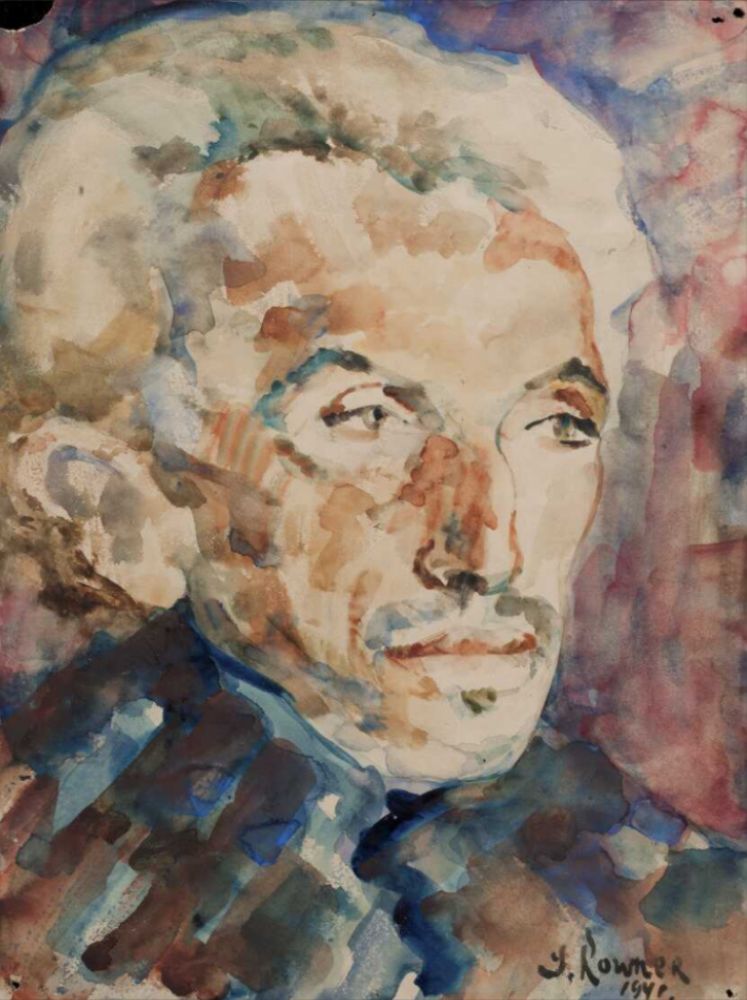- News
- Events
- Oneg Shabbat
- Collections
- Research
- Exhibitions
- Education
- Publishing Department
- Genealogy
- About the Institute
- Bookstore


During the decades preceding the German invasion of Poland, in September, 1939, he was working actively as a portrait painter. He participated in collective exhibitions of young Łódź Jewish artists, of whom the most famous were „St.Art” — abbreviation for „The Association of Artists”. He also created abstract, symbolical drawings and illustrations, often on Jewish subject matter. His works had been exhibited at the exhibitions in Łódź, Cracow and Warsaw., He donated a few of his early works to the new municipal art museum in Łódź.
The key period of his life and work was the time spent in the Łódź Ghetto. He made there a lot of drawings depicting scenes of everyday life; he made many portraits. He painted a few portraits of his protector, Chaim Rumkowski, the chairperson of a Judenrat there. He was also forced to do portraits of the Nazis.
Before the war, Lejzerowicz had a workshop in the centre of Łódź, in a big building at 49 Kilińskiego Street, a building, whose history is strictly linked to the history of the Jewish community of this city. When he was staying in the ghetto, he lived and worked at 14a Rybna Street. At the time, he led an artistic-literary salon. Artists writing in many languages: Yiddish, Polish, German and probably Russion would gather there. Both for the artist and his guests it was a way to save their dignity.
The Emanuel Ringelblum Jewish Historical Institute in Warsaw possesses the biggest collection of the originals of Lejzerowicz’s drawings and paintings. They were donated to the Institute by the artist’s sister, Zofia Lejzerowicz Rozynes. The majority of the drawings can be considered to be the documentation of the life in the Łódź Ghetto. Moreover, it is possible to notice in them the desire to record and freeze the uniqueness of the scenes of „everyday existence.” The drawings are precise. Seemingly, they are nothing special. However, to say that they are only documentation of the past is like saying that Rembrandt painted Biblical scenes: everything and nothing at the same time. From this period, portraits and „genre scenes” predominate. Sometimes, there are drawing humorous in terms of their content. Let’s look at them a bit closer.
In the ghetto a whole series of portraits of strangers and Lejzerowicz’s friends was made. The first drawing worth paying attention to is a portrait of a young woman on the balcony (crayons, 44 x 54 cm). It is different to other portraits of the time in terms of the depiction of the person. The woman is sitting on a chair and is presented in profile. In the background, we can see facades and roofs of the buildings. We do not know who the drawn woman is. This sketch gives us information on how the artist worked. We can see how he drew, what he paid special attention to, what he only outlined and what was of little importance to him. The composition is created using a few brown and blue lines. However, they managed to convey the atmosphere of the scene.
The second drawing, interior of a church, (crayon on paper; 21,5 x 35 cm), depicts the interior of a Gothic temple. We are looking at the presbytery, before are eyes hangs a huge candelabrum and on the left a pulpit. In the foreground there is a pile of eiderdowns, pillows and quilts accumulated in the church. It is a strange view, they fill the interior of the church; they resemble sea monsters washed ashore (drawn by Dutch artists, for example Hendrick Goltzius). These heaps of bedclothes were taken from the murdered. There are human figures stealing through them. They are small and inconspicuous. When we realise what Lejzorowicz really presented, we are deeply moved by the scene in the church.
The third drawing depicts a canteen (crayon, water-colour; 21 x 35 cm), a small room with a crowd of whirling people: eating, consuming, crammed and writhing. This whirl of people seems to be twitching before our eyes. Fear is noticeable as well as the desire to satisfy the hunger. The figures of the eating are drawn with a fast, shaky line. The colours are dusty, greyish, nondescript. Here and there, only cleaner stains of blue.